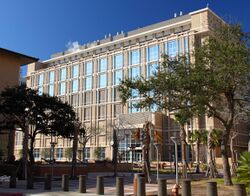Organization:Galveston National Laboratory
 | |
| Established | November 2008 |
|---|---|
| Research type | BSL-4 Biocontainment Laboratory |
Field of research | Infectious diseases Emerging pathogens Bioterrorism agents |
| Director | James W. LeDuc, Laboratory Director Scott C. Weaver, Scientific Director [1] |
| Staff | 300 |
| Location | Galveston, Texas, USA [ ⚑ ] : 29°18′38″N 94°46′43″W / 29.3106°N 94.7786°W |
| Campus | University of Texas Medical Branch at Galveston |
| Nickname | GNL |
| Affiliations | National Institute of Allergy and Infectious Diseases National Institutes of Health |
Operating agency | University of Texas Medical Branch with support from the National Institute of Allergy and Infectious Diseases and National Institutes of Health |
| Website | www.utmb.edu/gnl |
The Galveston National Laboratory (GNL) in Galveston, Texas , United States, is a high security National Biocontainment Laboratory housing several Biosafety level 4 research laboratories, run by the University of Texas Medical Branch for exotic disease diagnosis and research.[2] The GNL is one of only two such facilities in the United States and the largest one in the world located on an academic campus.[3][4]
History
In the early 2000s (decade), the United States experienced several events which led to its government pushing for the creation of more facilities to provide research to help defend against bioterrorism attacks. Under the direction of the U.S. Congress, the National Institutes of Health (NIH) began a nationwide search for a location to build a National Biocontainment Laboratory. In 2003, UTMB was chosen by the NIH as the site for one of two such national laboratories, and a $174 million federal grant was issued to pay for its construction. The Galveston National Laboratory is one of only two such facilities in the United States and the largest one in the world located on an academic campus.[3][4][5]
Statistics
Galveston National Laboratory is an eight-story structure that was built using construction standards designed to resist a Category 5 hurricane. In addition to structural design elements, other protective measures included support pilings reaching a depth of 120 feet (37 m) into the earth and the placement of all lab facilities at a height of at least 30 feet (9.1 m) above the 100-year floodplain.[4] The building houses more than 80,000 sq ft (7,400 m2) of laboratory space, of which 12,000 sq ft (1,100 m2) is dedicated to BSL-4 use. Other labs located in the building include BSL-3 facilities which research select & non-select agents in cell cultures, animal and insects.[4] The laboratory became operational in November 2008 and was dedicated by U.S. Senator Kay Bailey Hutchison.[6] Attached to and functioning as a part of the GNL is the older Keiller Building, which houses additional BSL-2 and BSL-3 laboratories, including an insect BSL-3 lab. Also attached is the Shope BSL-4 lab, a smaller BSL-4 facility built in 2005.
Notes and references
- ↑ http://www.utmb.edu/gnl/news/items/CAB_E-newsV5April10.pdf GNL Community Advisory Board Newsletter
- ↑ "Medical Branch formally breaks ground on lab". Galveston County Daily News. Archived from the original on 2012-02-24. https://web.archive.org/web/20120224041129/http://galvestondailynews.com/story.lasso?wcd=74826. Retrieved 2010-01-22.
- ↑ 3.0 3.1 ERIC BERGER. "UTMB on biowar front line / Lab funded by federal grant will seek defenses for terror". Houston Chronicle. http://www.chron.com/CDA/archives/archive.mpl?id=2003_3694825. Retrieved 2010-01-22.
- ↑ 4.0 4.1 4.2 4.3 Kelly, Jim (January 2010). "A Port in the Storm". UTMB Magazine 10.1: 11–13
- ↑ "Texas in Focus: Gulf Coast Region, Healthcare". Texas Comptroller of Public Accounts. http://www.window.state.tx.us/specialrpt/tif/gulf/pdf/07_Health_Care.pdf. Retrieved 2010-05-10.
- ↑ Eric Berger. "UTMB / Galveston National Laboratory dedicated". Houston Chronicle. http://www.chron.com/CDA/archives/archive.mpl?id=2008_4679319. Retrieved 2010-01-22.
External links

